
The BRP Bacolod City (LS-550) is the lead ship of two Bacolod City class logistics support vessel, and is based on a helicopter capable variant of the US Army's Frank S. Besson class. She is also considered one of the most modern transport ships in the Philippine Navy, having been commissioned during the early 1990s. She was previously known as BRP Bacolod City (LC-550) prior to a classification change implemented by the Philippine Navy starting April 2016.

The BRP Rajah Humabon (PS-11) was a former destroyer escort of the United States Navy and a former frigate of the Philippine Navy. She was the last World War II-era destroyer escort/frigate active in her fleet, and one of the oldest active warships in the world, until 15 March 2018 when she was formally decommissioned after 75 years. She was one of three ex-USN Cannon-class destroyer escorts that served the Philippine Navy, the others being BRP Datu Sikatuna (PF-5/PS-77) and BRP Datu Kalantiaw (PS-76).

The BRP Quezon (PS-70) was one of two Rizal class ships in service with the Philippine Navy. She was formerly a USN Auk class minesweeper produced during World War II, and was later on classified as a patrol corvette protecting the vast waters of the Philippines.
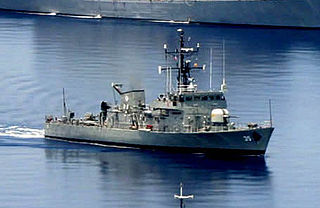
The BRP Emilio Jacinto (PS-35) is the lead ship of the Jacinto-class corvettes currently assigned to the Offshore Combat Force of the Philippine Fleet. She is one of few ships in the Philippine Navy equipped with modern systems after the completion of combat, navigation and weapon systems upgrade of her class in August 2019. She was originally called HMS Peacock (P239) during her service with the Royal Navy.

BRP Miguel Malvar (PS-19) is the lead ship of the Miguel Malvar class of corvettes of the Philippine Navy. She was originally built as USS Brattleboro PCE(R)-852, a PCE(R)-848-class rescue patrol craft escort for the United States Navy during World War II. In 1966 she was transferred to South Vietnam for service in the Republic of Vietnam Navy as RVNS Ngọc Hồi (HQ-12). She was acquired by the Philippine Navy in April 1976 and later on commissioned as Miguel Malvar after Miguel Malvar y Carpio. The ship is in active service. Along with other World War II-era ships of the Philippine Navy, Miguel Malvar is one of the oldest active fighting ships in the world today.

BRP Pangasinan (PS-31) was a Miguel Malvar-class corvette of the Philippine Navy. She was originally built as USS PCE-891, a PCE-842-class patrol craft for the United States Navy during World War II. She was decommissioned from the U.S. Navy and transferred to the Philippine Navy in July 1948 and renamed RPS Pangasinan (E-31).
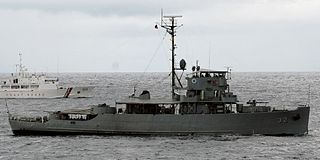
BRP Iloilo (PS-32) was a Miguel Malvar-class corvette of the Philippine Navy. She was originally built as USS PCE-897, a PCE-842-class patrol craft for the United States Navy during World War II. She was decommissioned from the U.S. Navy and transferred to the Philippine Navy in July 1948 and renamed RPS Iloilo (E-32) after the Philippine province of the same name. Along with other World War II-era ships of the Philippine Navy, Iloilo was considered one of the oldest active fighting ships in the world, being in continuous service for over seven decades.
The BRP Dioscoro Papa (PC-381) is the eleventh ship of the Jose Andrada class coastal patrol boats of the Philippine Navy. It is part of the second batch of its class ordered through US Foreign Military Sales (FMS) in 1993, and was commissioned with the Philippine Navy on 1 June 1995.
BRP Bonny Serrano (PC-111) was a Tomas Batilo-class fast attack craft of the Philippine Navy. It is part of the first batch transferred by the South Korean government on 15 June 1995, and arrived in the Philippines in August 1995. It was commissioned with the Philippine Navy on 22 May 1996,
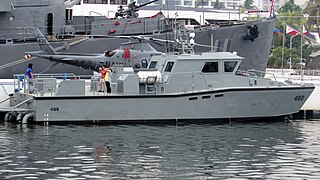
The Multi-Purpose Assault Craft (MPAC) is a type of fast attack assault craft developed for the Philippine Navy. Originally designed to transport troops at a high speed and then land them on the beach, they have since expanded their roles to include interdiction, surface warfare, and search and rescue.
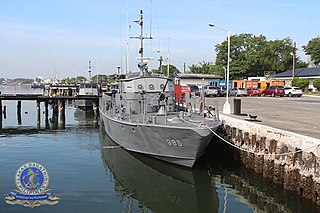
BRP Felix Apolinario (PC-395) is twenty-second and final ship of the Jose Andrada-class patrol craft of the Philippine Navy. She was commissioned in 2000 and is currently in active service with the Littoral Combat Force, Philippine Fleet.

The Tarlac class are landing platform docks of the Philippine Navy meant for amphibious operations and transport duties in support of the Armed Forces of the Philippines. The class was initially called the "Strategic Sealift Vessel" before being formally named. The ships will also double as a support platform for Humanitarian and Disaster Relief (HADR) and Search & Rescue (SAR) operations.
BRP Waray (LC-288) is a heavy landing craft of the Philippine Navy. From 1972 to 2012, it was known as HMAS Betano (L 133) and served the Royal Australian Navy. Betano was decommissioned in December 2012 and stored until it was sold by the Australian government to the Philippine Navy to assist in improving the country's humanitarian and disaster relief capabilities.
The BRP Agta (LC-290) is a landing craft heavy of the Philippine Navy. From 1972 to 2012, it was known as HMAS Balikpapan (L 126) and served the Royal Australian Navy. It was decommissioned in December 2012, was stored until it was sold by the Australian government to the Philippine Navy to assist in improving the country's Humaritarian and Disaster Relief capabilities.
The BRP Iwak (LC-289) is a heavy landing craft of the Philippine Navy. From 1972 to 2012, it was known as HMAS Wewak (L 130) and served the Royal Australian Navy. It was decommissioned in December 2012, was stored until it was sold by the Australian government to the Philippine Navy to assist in improving the country's Humaritarian and Disaster Relief capabilities.
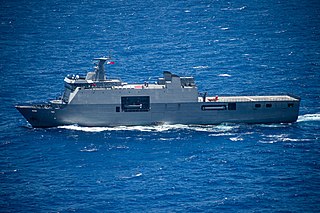
BRP Davao del Sur (LD-602) is the second ship of the Tarlac-class landing platform dock of the Philippine Navy. She is the second ship to be named after the Philippine province of Davao del Sur, one of the main provinces in Mindanao in Southern Philippines. She was launched on 29 September 2016 and was commissioned into service on 31 May 2017.
BRP Anastacio Cacayorin (PC-387) is the sixteenth ship of the Jose Andrada-class patrol craft coastal patrol craft of the Philippine Navy. She was commissioned in 1996 and is currently in active service with the Littoral Combat Force, Philippine Fleet.
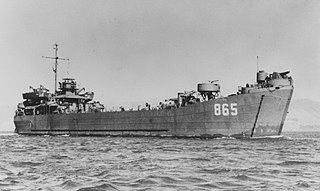
USS LST-865 was a LST-542-class tank landing ship in the United States Navy during World War II. She was transferred to the Philippine Navy as RPS Albay (T-39).

The BRP Mamanwa (LC-294) is a landing craft utility of the Philippine Navy. She was named after the Mamanwa tribe, one of the Lumad tribes in Mindanao Island in the Southern Philippines. She is the sole Mulgae-class landing craft in Philippine Navy service.













